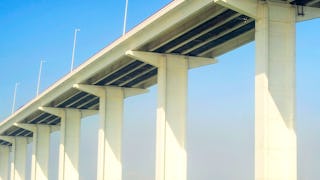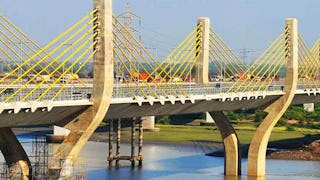We delve into the substructure, the crucial support system holding the bridge deck. You'll learn to design piers, the pillars taking the bridge's weight, and abutments providing support at the ends. Analyzing forces acting on these structures and designing them for strength and stability, even during earthquakes, is a key focus. Different pier designs and bearing systems that transfer the bridge's weight to the ground will be explored.


Foundation Systems, Monitoring and Erection Methods
This course is part of Bridge Infrastructure Design Specialization

Instructor: Subject Matter Expert
Included with
Recommended experience
Skills you'll gain
- Architecture and Construction
- Failure Analysis
- Construction
- Engineering Calculations
- Engineering Design Process
- Construction Engineering
- Structural Engineering
- Engineering Practices
- Structural Analysis
- Engineering
- Continuous Monitoring
- Environmental Monitoring
- Property Maintenance
- Civil Engineering
- Maintenance, Repair, and Facility Services
Details to know

Add to your LinkedIn profile
4 assignments
See how employees at top companies are mastering in-demand skills

Build your subject-matter expertise
- Learn new concepts from industry experts
- Gain a foundational understanding of a subject or tool
- Develop job-relevant skills with hands-on projects
- Earn a shareable career certificate

There are 4 modules in this course
This module dives deep into the foundation of bridges! We'll explore various substructure systems, from the cantilever piers that support the bridge deck to abutments. You'll learn the intricacies of designing cantilever piers, understanding their load-bearing capacity and ensuring their stability. We'll delve into different pier types like portal piers, and explore various bearing systems that transfer the bridge's weight to the ground. The module covers pedestals and seismic restrainers, crucial components for keeping the bridge stable during earthquakes. By the end, you'll gain ability to design piers and other substructure systems.
What's included
18 videos1 assignment
This module tackles the critical underground support system for bridges. We'll explore various foundation types, from open foundations to pile foundations for deeper support needs. You'll delve into geotechnical considerations, understanding how soil properties influence foundation design. We'll cover the design process for pile foundations, including pile types, capacity analysis, and ensuring their stability under different load scenarios. Well foundations, suitable for deep water or weak soil, will also be explored. By the end, you'll gain the knowledge to design safe and secure foundations, the cornerstone of any enduring bridge structure.
What's included
13 videos1 assignment
In this module we'll explore how bridges are monitored during construction to identify potential issues early on. You'll learn about installing sensors to track the bridge's behavior after construction, allowing for data-driven maintenance decisions. The module covers periodic inspections using visual and specialized techniques to detect problems. We'll delve into routine maintenance tasks like replacing bearings and expansion joints, crucial for bridge longevity. Even bridge widening to accommodate changing traffic needs will be explored. By understanding these practices, you'll be able to practice measures for bridge monitoring that keep our bridges reliable and safe.
What's included
6 videos1 assignment
In this module, we'll explore some bridge projects, from concept to completion. You'll learn about different bridge types in action, including pre-stressed and post-tensioned I-girder bridges, majestic steel truss bridges, and modern marvels like balanced cantilever and cable-stayed bridges. We'll delve into the specific construction methods used for each type, like segmental construction for pre-stressed I-girder bridges and the impressive balanced cantilever method for achieving large spans. You'll even explore the intricacies of cable-stayed bridge construction. Through real-world case studies, you'll gain a holistic understanding of how these bridges are brought to life, showcasing the engineering ingenuity.
What's included
10 videos1 assignment
Earn a career certificate
Add this credential to your LinkedIn profile, resume, or CV. Share it on social media and in your performance review.
Instructor

Offered by
Explore more from Environmental Science and Sustainability

L&T EduTech

L&T EduTech
Why people choose Coursera for their career





Open new doors with Coursera Plus
Unlimited access to 10,000+ world-class courses, hands-on projects, and job-ready certificate programs - all included in your subscription
Advance your career with an online degree
Earn a degree from world-class universities - 100% online
Join over 3,400 global companies that choose Coursera for Business
Upskill your employees to excel in the digital economy
Frequently asked questions
To access the course materials, assignments and to earn a Certificate, you will need to purchase the Certificate experience when you enroll in a course. You can try a Free Trial instead, or apply for Financial Aid. The course may offer 'Full Course, No Certificate' instead. This option lets you see all course materials, submit required assessments, and get a final grade. This also means that you will not be able to purchase a Certificate experience.
When you enroll in the course, you get access to all of the courses in the Specialization, and you earn a certificate when you complete the work. Your electronic Certificate will be added to your Accomplishments page - from there, you can print your Certificate or add it to your LinkedIn profile.
Yes. In select learning programs, you can apply for financial aid or a scholarship if you can’t afford the enrollment fee. If fin aid or scholarship is available for your learning program selection, you’ll find a link to apply on the description page.
More questions
Financial aid available,

